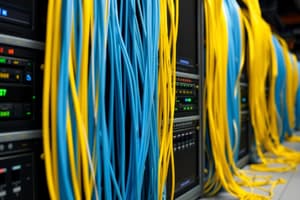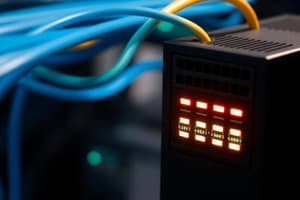Podcast
Questions and Answers
Which of the following describes the function of servers in a network?
Which of the following describes the function of servers in a network?
- Servers act only as clients to access other servers.
- Servers host applications and provide services to other hosts on the network. (correct)
- Servers can only store files and cannot provide web services.
- Servers operate independently, without any client communication.
In a peer-to-peer (P2P) network, what role can a computer fulfill?
In a peer-to-peer (P2P) network, what role can a computer fulfill?
- Only as a server for all other computers.
- Simultaneously act as both a client and a server. (correct)
- Exclusively as a client that requests data.
- Only as a switch to interconnect devices.
What can slow down the performance of a host in a P2P network?
What can slow down the performance of a host in a P2P network?
- Acting both as a client and a server at the same time. (correct)
- Having too many clients connected to a server.
- Using a wired connection instead of a wireless one.
- Exceeding the storage capacity of a server.
Which software is typically used by clients to access web pages?
Which software is typically used by clients to access web pages?
What is a key characteristic of a peer-to-peer network?
What is a key characteristic of a peer-to-peer network?
Which software is required for a host to provide web services?
Which software is required for a host to provide web services?
Which of the following services provides the highest bandwidth using existing telephone lines?
Which of the following services provides the highest bandwidth using existing telephone lines?
What is a function of an ISP when connecting a home network to the internet?
What is a function of an ISP when connecting a home network to the internet?
What type of network is characterized by both clients and servers residing on the same devices?
What type of network is characterized by both clients and servers residing on the same devices?
Which component is NOT typically classified as part of the network's infrastructure?
Which component is NOT typically classified as part of the network's infrastructure?
What common characteristic defines cable internet connections?
What common characteristic defines cable internet connections?
What is a primary feature of a wireless integrated router?
What is a primary feature of a wireless integrated router?
Which of the following is NOT considered an end device in a network?
Which of the following is NOT considered an end device in a network?
What defines end devices in a network infrastructure?
What defines end devices in a network infrastructure?
Which of the following is NOT considered an intermediary device?
Which of the following is NOT considered an intermediary device?
How does a computer serve multiple clients within a network?
How does a computer serve multiple clients within a network?
What is the primary function of an Internet Service Provider (ISP)?
What is the primary function of an Internet Service Provider (ISP)?
What do end devices rely on to identify each other within a network?
What do end devices rely on to identify each other within a network?
What is the primary medium used to connect the internet backbone?
What is the primary medium used to connect the internet backbone?
What must be used to securely connect a computer to an ISP?
What must be used to securely connect a computer to an ISP?
What is a major limitation of cellular internet access?
What is a major limitation of cellular internet access?
What type of connection is typically used for satellite internet access?
What type of connection is typically used for satellite internet access?
What is the primary function of Equipment Co-Location offered by ISPs?
What is the primary function of Equipment Co-Location offered by ISPs?
Flashcards are hidden until you start studying
Study Notes
Network Hosts and Roles
- Hosts are computers directly participating in network communication, capable of sending and receiving messages.
- Modern hosts can function as clients, servers, or both, depending on the installed software.
- Email services require an email server software on hosts; clients use applications like Microsoft Outlook.
- Web services are accessed through browsers like Internet Explorer or Firefox, relying on web server software on hosts.
- File services involve centralized storage accessible via clients using software like Windows File Explorer.
Peer-to-Peer Networks
- P2P networks allow computers to function as both clients and servers simultaneously.
- Simplest P2P network consists of two directly connected computers, either wired or wireless.
- In larger P2P setups, interconnection requires a network device, such as a switch.
- Disadvantages include potential performance slowdowns and lack of centralized administration, security, and scalability.
- Advantages include easy setup, low cost, and suitability for simple tasks like file sharing.
Peer-to-Peer Applications
- P2P applications enable devices to act as both client and server in communications, requiring a user interface and background service.
- Hybrid P2P systems decentralize resource sharing but utilize a centralized directory for indexing resource locations.
Multiple Roles in Networking
- One computer can simultaneously provide multiple services to various clients and run diverse server and client software.
- Clients must have the necessary software to connect to various services, allowing simultaneous tasks like checking email and browsing the web.
Network Infrastructure
- Network infrastructure supports communication, comprising three hardware categories: end devices, intermediate devices, and network media.
- End devices include computers, printers, phones, and mobile devices; intermediary devices consist of routers and switches; network media includes wired and wireless connections.
End Devices
- End devices serve as interfaces between users and the network, initiating or receiving messages.
- Unique addresses identify hosts; when a host communicates, it specifies the destination address.
- Common end device examples encompass various types of computers, printers, teleconferencing equipment, and security cameras.
Internet Service Provider (ISP) Services
- ISPs connect home networks to the internet and can be cable, landline, or cellular providers.
- Additional ISP services may include email accounts, network storage, and technical support.
- ISPs are interconnected hierarchically, optimizing internet traffic flow using high-speed fiber-optic cables.
ISP Connections
- Connecting to an ISP typically involves a modem and a router for safe internet access.
- Using a router provides necessary security features and enables multiple devices to connect to the internet.
Cable and DSL Connections
- Cable connections share coaxial cables with television services, providing high-bandwidth internet access through specialized modems.
- DSL uses existing phone lines, separating voice and data signals to maintain simultaneous access; it has three distinct channels for voice and data.
- Cellular internet access relies on mobile networks, offering connectivity wherever there is a signal, although subject to bandwidth limits.
- Satellite service is beneficial for remote areas without DSL or cable access, using dish antennas for connectivity, but may incur high equipment costs.
Conclusion
- Understanding the roles of hosts, the structure of networks, and various connectivity methods helps in comprehending modern network operations and communications.
Studying That Suits You
Use AI to generate personalized quizzes and flashcards to suit your learning preferences.




